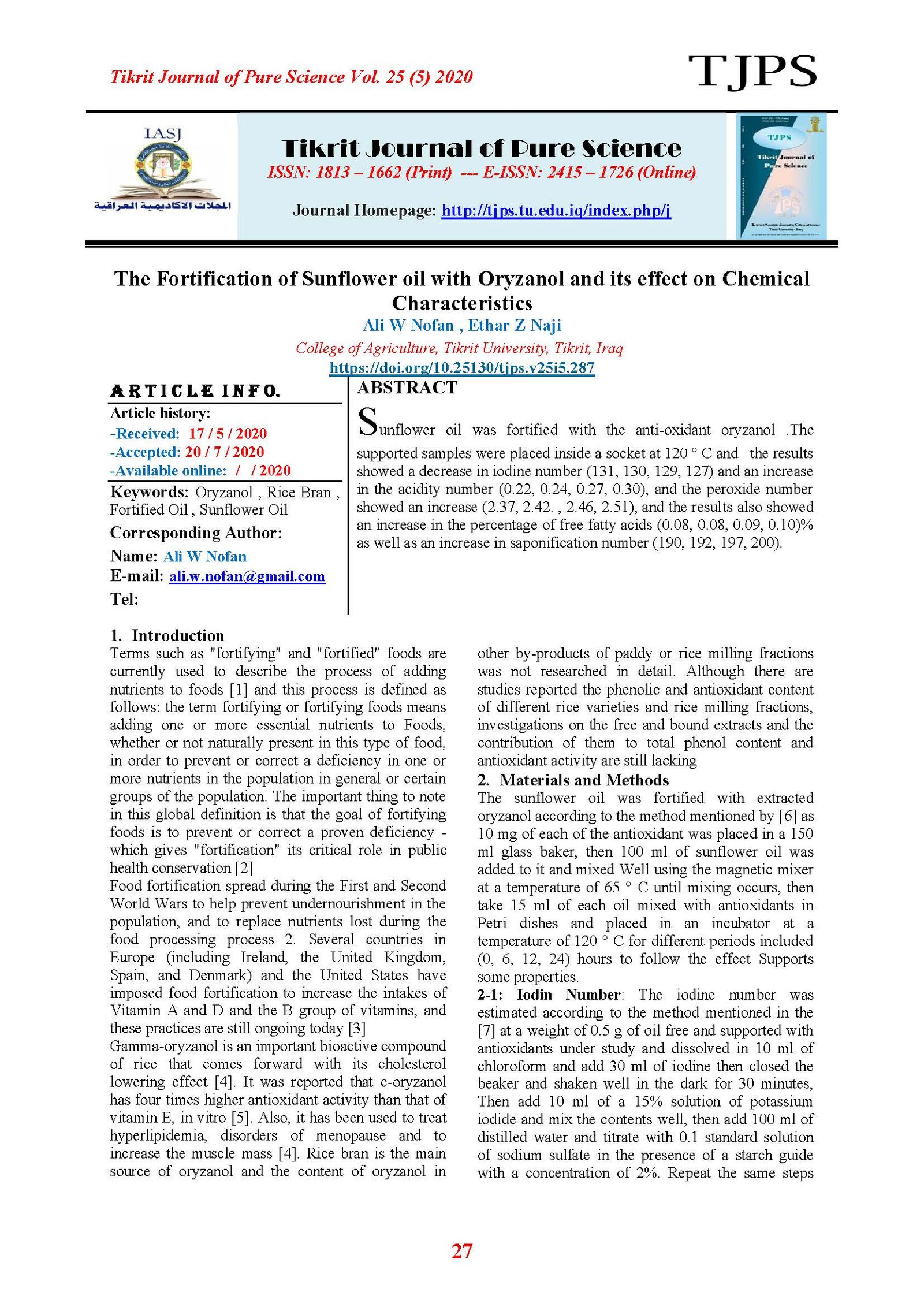The Fortification of Sunflower oil with Oryzanol and its effect on Chemical Characteristics
Main Article Content
Abstract
Sunflower oil was fortified with the anti-oxidant oryzanol .The supported samples were placed inside a socket at 120 ° C and the results showed a decrease in iodine number (131, 130, 129, 127) and an increase in the acidity number (0.22, 0.24, 0.27, 0.30), and the peroxide number showed an increase (2.37, 2.42. , 2.46, 2.51), and the results also showed an increase in the percentage of free fatty acids (0.08, 0.08, 0.09, 0.10)% as well as an increase in saponification number (190, 192, 197, 200).
Article Details

This work is licensed under a Creative Commons Attribution 4.0 International License.
Tikrit Journal of Pure Science is licensed under the Creative Commons Attribution 4.0 International License, which allows users to copy, create extracts, abstracts, and new works from the article, alter and revise the article, and make commercial use of the article (including reuse and/or resale of the article by commercial entities), provided the user gives appropriate credit (with a link to the formal publication through the relevant DOI), provides a link to the license, indicates if changes were made, and the licensor is not represented as endorsing the use made of the work. The authors hold the copyright for their published work on the Tikrit J. Pure Sci. website, while Tikrit J. Pure Sci. is responsible for appreciate citation of their work, which is released under CC-BY-4.0, enabling the unrestricted use, distribution, and reproduction of an article in any medium, provided that the original work is properly cited.
References
[1] Onemli F (2012) Impact of climate changes and correlations on oil fatty acids in sunflower. Pakistan Journal of Agricultural Science 49 (3) : 455-458.
[2] Semba R.D; Moench-Pfanner. R; Sun. K ; De Pee. S; Akhter. N; Rah. J.H; Campbell. A.A; Badham. J; Bloem. M.W; Kraemer. K.( 2011) Consumption of micronutrient-fortified milk and noodles is associated with lower risk of stunting in preschool-aged children in Indonesia. Food Nutr Bull . 32(1) :347–53.
[3] Hoppe. M ; Hulthen. L. and Hallberg. L. (2005) The relative bioavailability in humans of elemental iron powders for use in food fortification. European Journal of Nutrition 45 (3) , pages37–44.
[4] Tuncel. N ; Yilmaz. N (2011) Gamma-oryzanol content, phenolic acid profiles and antioxidant activity of rice milling fractions. Eur Food Res Technol 33( 2 ):577–585.
[5] Saenjum . C ; Chaiyasut. C; Chansakaow. S; Suttajit. M ; Sirithunyalug. B. (2012). Antioxidant and anti-inflammatory activities of gamma-oryzanol rich extracts from Thai purple rice bran. J Med Plants Res, 6, 1070-7.
[6] Schulte. L.R; Ballard .T; Samarakoon.T ;Yao. L ; Vadlani. P; Staggenborg. S and Rezac. M (2013) Increased growing temperature reduces content of polyunsaturated fatty acids in four oilseed crops. Industrial Crops and Products 51(2): 212-219.
[7] Association of Official Analytical Chemists, A.O.A.C. (2004). Association of Official Chemists, 12th ed ., Washington, D.C.
[8] Grunvald. A.K; Carvalho. C.G.; Leite . R. S; Mandarino .J.M.; Andrade . C.A.; Amabile . R.F and Godinho. V.D. (2013) Influence of temperature on the fatty acid composition of the oil from sunflower genotypes grown in tropical regions. Journal of the American Oil Chemists Society 90 (3) : 545-553.
[9] Gupta .M.K (2014) Sunflower oil: history, applications and trends. Lipid Technology 26: 260-263.
[10] Grad. B.B. and Sahi, A. (2013). The effect of storage duration and temperature on the physiochemical properties of purified wheat germ oil. Basra Science Journal, 39(4) : 118 - 127.
[11] Massarolo, K.C.; De Souza, T.D.; Collazzo, C.C.; Furlong, E.B.; de Souza Soares, L.A. (2017)
The impact of Rhizopus oryzae cultivation on rice bran: Gamma-Oryzanol recovery and its antioxidant properties. Food Chem. 228, 43–49.
[12] Abd Razak, D.L.; Abd Rashid, N.Y.; Jamaluddin, A.; Sharifudin, S.A.; Long, K. (2015) Enhancement of phenolic acid content and antioxidant activity of rice bran fermented with Rhizopus oligosporus and Monascus purpureus. Biocatal. Agric. Biotechnol.4: 33–38.
